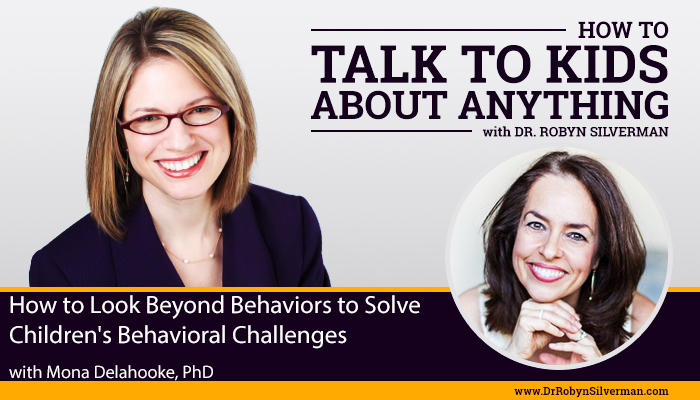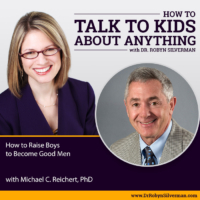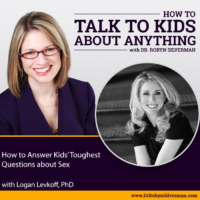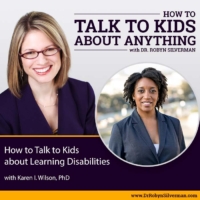Podcast: Play in new window | Download
Subscribe: Apple Podcasts | RSS | More
How to Look Beyond Behaviors to Solve Children’s Behavioral Challenges
This podcast will focus on looking beyond behaviors to understand and help solve children’s behavioral challenges. Behavior is simply and outward expression of inward emotions—so if we just work to correct the behaviors we see, we miss a great deal of the problem! By looking beneath the surface, we begin to understand the true nature of the child, his/her triggers and the possible solutions that will help the child to better cope with the stressful situation. Guest, Mona Delahooke and Dr. Robyn Silverman explore what’s beyond behaviors in the children we love.
Special guest: Mona Delahooke, PhD
A kindergartener whose father pinches her on the arm at night- once for every time her teacher wrote the girl’s name on the behavior chart at school that day.
chart at school that day.
A three year old in foster care who was found sitting in a car by the side of the road with his mother, who was passed out at the wheel. His daycare-center teacher sends him to a time out room for challenging behaviors.
A ten year old is diagnosed with Oppositional Defiant Disorder. His teachers say he is chronically disruptive, always seeking attention, His problematic behaviors began after his family relocated to a new state.
My next guest says that we are too quick to look at behaviors as attempts to annoy and disrupt—rather than what they truly represent- observable responses to our internal and external experiences. And here’s the problem with that- When we fail to recognize that many behaviors represent the body’s response to stress, not intentional misbehavior, we expend effort on techniques designed to help children logically connect their thoughts, emotions and behaviors and change them—when they simply can’t yet. Instead, we need to see the behavior that is problematic and confusing and NOT ask ourselves how do we get rid of it? But rather, what is this telling us about the child? The answer will then guide us to coming up with the best approach to help that individual child thrive.
Mona Delahooke, Ph.D. is a clinical child psychologist with a passion for supporting families and children. She has worked widely with multidisciplinary teams in the areas of trauma, developmental and emotional differences for 25 years. She is a senior faculty member of the Profectum Foundation and is a trainer and consultant to schools and agencies including the Los Angeles Department of Mental Health. Her blog, The Visible Parent, and book, Social & Emotional Development in Early Intervention (2017) explore the latest translational applications of neuroscience to social and emotional development. She is also the author of Beyond Behaviors: Using Brain Science and Compassion to Understand and Solve Children’s Behavioral Challenges.
The podcast provides:
- Why we must look beneath the iceberg to what the behaviors mean and how to respond.
- The difference between a stress response and intentional challenging behavior.
- What we need to know about our children’s autonomic pathways.
- How parents/educators know when to discipline and when to empathize with their children at a time when behavior is defiant or disruptive.
- Understanding for the adaptive purposes of negative behaviors
- Perspective of when a child gains control over their emotions
- Strategies that we can use to help children when their behavior is challenging.
Important Messages:
- We are too quick to look at behaviors as attempts to annoy and disrupt—rather than what they truly represent- observable responses to our internal and external experiences.
- We need to see the problematic and confusing behavior and NOT ask ourselves how do we get rid of it? But rather, what is this telling us about the child
- We need to use love and compassion to help our vulnerable children.
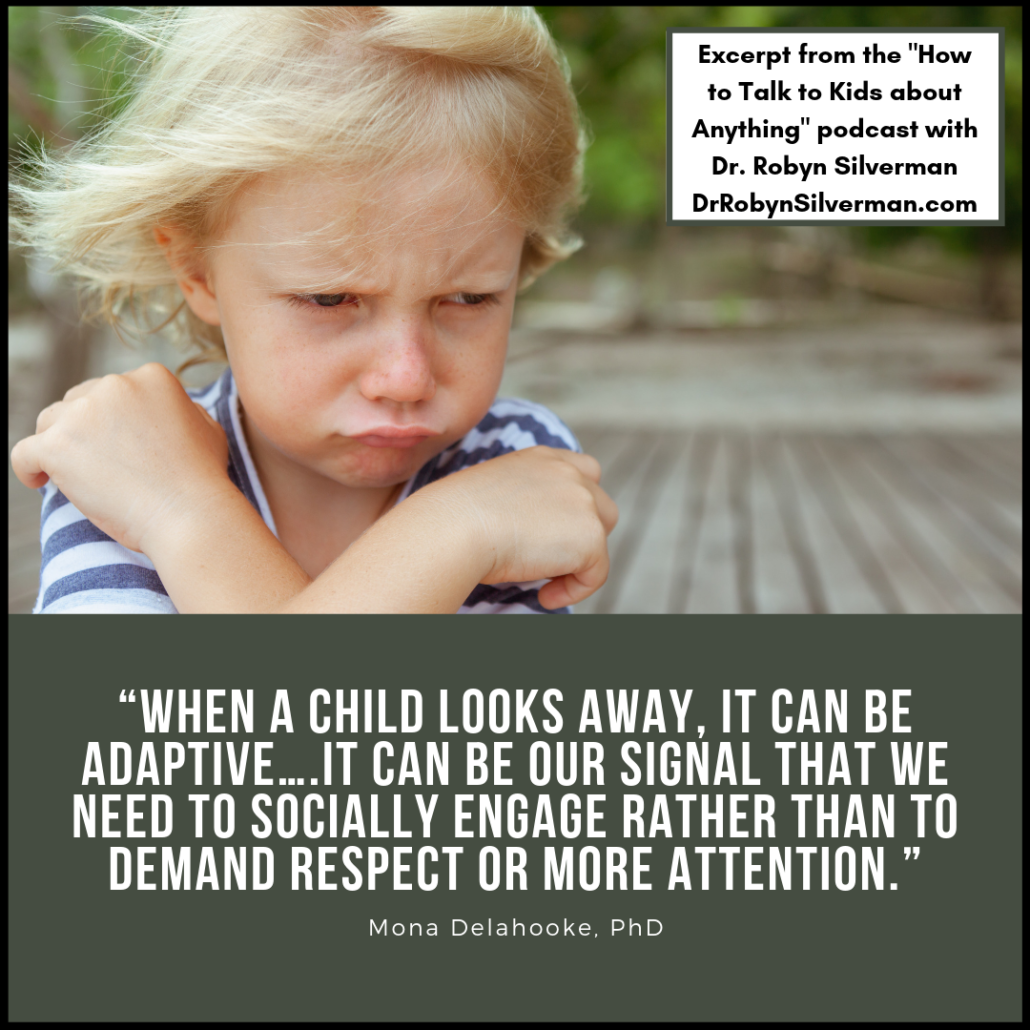
- We must look beneath the iceberg—the tip of the iceberg is only 10% of the iceberg and 90% lies below the waterline. The behaviors are like the tip. The causes and triggers- the motivating factors, the reasons—are found below the surface. They are found in the brain and body. When we just focus on what we see- we miss so much. When we focus on what’s really happening, our approach can change.
- Example: Child in grocery store.
- Tantrum: Described by what we see- hitting, crying, yelling, face red, flailing. Bottom-up behavior- response to stress- not in control of our behavior (emotions in control). Tantrum at tip of ice berg. Underneath- memories, tired, stress. Must consider that some behaviors are not intended to get attention or cause frustration but rather, responses to stress.
- Perspective: Child is suffering vs the child needs to get with the program and buck up.
- Remember as an adult- when you were upset and said or did something that elicited an angry response—you feel worse, not better!
- Expectation gap/ Believing that children have control over emotions and behavior when they don’t yet.
- Know your child and their individual differences. What is difficult to do or to manage?
- Example: Tapping pencil on the table at school. Repetitive behavior- way of managing being in a certain situation. They might have trouble staying still. Or the hum of the air conditioner in the classroom is annoying them. It’s an adaptive behavior. We have discrimination against so many behaviors- thinking they are loud and wrong. But in this case- most behaviors like this have adaptive component.
- Script: That child’s individual differences needs a script such as-> “Honey, it seems that tapping on the desk right now with your pencil is something you really need. Let us figure out together if that’s what you have to do or if there is something else you can do to make you feel better as well because for your friend sitting next to you, it’s a little tough on his ears to listen to the tapping of the pencil.” Then we are working on empathy as well for a child who might have auditory sensitivity issues.
- Individual differences are vital to consider.
- What to do? Individualize child—and their behavior. Empathize with them. See how behavior how affects others. Come up with another behavior that could work for them without it hurting someone else.
- Individual differences; Processing in body, sensations, feeling and thoughts.
- Tapping pencil: Body processes (sitting still- need to move- in order to stay calm to regulate- tapping pencil is a type of movement- physiological need to move.) Message- assume that all kids have the same sensory needs. But they don’t! Needs not preferences! We’ll talk to children until we’re blue in the face! Talking knowing the whole child.
- Pathways- Main ways of being in the world. Green- calm, listening, present, able to remember things, available, play, laugh. They can have social engagement. Talk to others, ask for help when need it. When this doesn’t work—Red- move away, aggressive, hit, yell, scream. Evolve to escape dangerous situations. Fight or flight. Blue: Disconnection. Signals vulnerability. They don’t want to talk. Looking down. Shutting down. Get there when the other two aspects don’t work. Can lead to depression and hopelessness.
- Shut down mode- not defiance—used when the other two aren’t working (green or red). Adaptive. Don’t demand eye contact!
- “Script: “I want you to know this conversation is tough. I just want you to know- I’m here with you and this is a little time of suffering for both of us.” This is a signal to socially engage and not demand respect.
- No shame, no blame zone to parents and to children. Parents- we need to be gentle with ourselves.
- Example: Trouble going to bed. Parents have them lose privileges, putting locks on door. But if we look beyond the tip of the iceberg. Look at emotional regulation—being able to feel safe and calm when you are by yourself. Developmental challenge. To help a child who is having trouble going to bed—tip of iceberg says “defiance.” But below- anxiety when can’t touch parent. Adaptive- using green pathway (social engagement) to calm down- they are coming out of room to find us. Flip lens. NOT behavior problem- emotional regulation problem. Rather than getting third cup of water…
- Script: “Wow. You’ve already had 2 cups of water so maybe not so thirsty. But maybe we can talk about how hard it is to fall asleep or separate from Mommy when you can’t see me or touch me. Is that maybe a little bit touch for you?” Some can’t talk about it- won’t be in consciousness. Maybe just cry. Maybe need new sleep hygiene routine. Start an hour earlier. Look for green pathway. Sometimes try to put them to bed when they are in light red, light green pathway. Look at body-mind connection.
- How do you read your child’s body-mind connection? What do they need from you to feel safe? Once they feel safe, the behavior problems don’t exist.
- Most neuro-scientists say it’s not until our 20s or 30s to get full executive function. So we can’t expect it so early!
- Social problem-solving—once they understand feelings, they can start with talking about co-creating the solutions. Name body-mind experiences (i.e. happy camper, fireworks). Build the foundation.
- The most severe responses are actually stress responses- need to reframe. Lots of ways to look at behaviors. Awesome and loving things can happen!
Notable Quotables:
-
-
- “We must use love and compassion to help our vulnerable children instead of blaming them for challenging
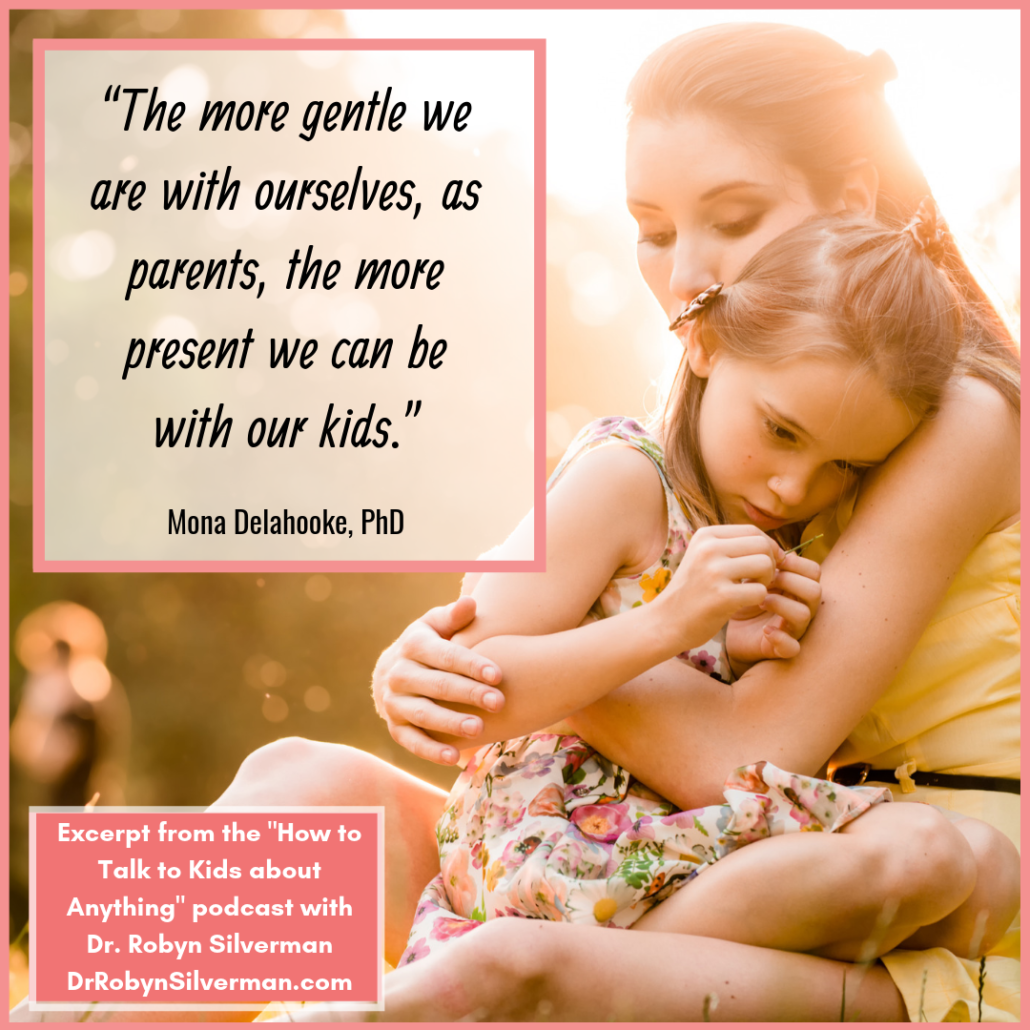 behaviors.”
behaviors.” - “Some behaviors are not children’s desire to get attention or get their own way. They are responses to their own stress.”
- “We have an expectation gap: We believe that children have intentional control over their emotions and behaviors way sooner than they actually do.”
- “When a child looks away, it can be adaptive….it can be our signal that we need to socially engage rather than to demand respect or more attention.”
- “The more gentle we are with ourselves, as parents, the more present we can be with our kids.”
- “The most severe and challenging behaviors in our children are actually stress responses. We need to have compassion as ourselves as parents, teachers and caregivers as well as for our kids so that we can reframe the way we view these challenges. Once we do this and once we see that there is another way to look at these behaviors as a child is struggling, really awesome and loving things can happen.”
- “We must use love and compassion to help our vulnerable children instead of blaming them for challenging
-

